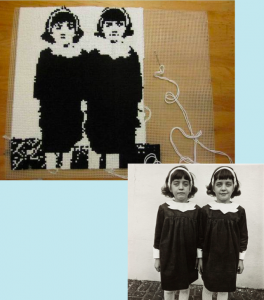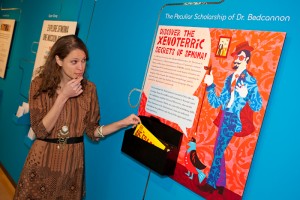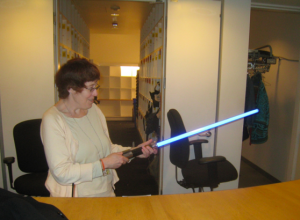I recently got a chance to ask Erica Gangsei some questions about the exhibition ArtGameLab, currently on view at the San Francisco Museum of Modern Art (and awaiting your participation). Erica’s official title is Manager of Interpretive Media at SFMOMA – that means she’s an in-house media producer and digital publisher. With her team, Erica works to bridge the gap between the artworks and museum visitors through audio tours, video interviews with artists, podcasts and onsite educational spaces.
Erica had so much great stuff to share that I’ll be posting this in two parts. Here’s the first half – part two on it’s way tomorrow! is now up.
Sara Thacher: In your original request for proposals last summer, you mentioned iPod Touches and computers that could be made available for these games. Although some have web-based components, the five games that you selected all center around a very low-tech, paper interaction. Why did you decide not to include screens in this exhibition?
Erica Gangsei: Paper-based games provided a simple production advantage – one can produce more with less. The purpose of the exhibition was to present a range of experimental approaches – going analog allowed us to do that.
Beyond that, I found that many of the proposals for non-electronic games were thinking further outside of the box – their ideas, simply put, were more inventive, more engaging and generally quirkier than their digital counterparts. Analog games are also unexpected in the field, as most of the popular discussions about gaming trends focus on digital games. Online and video games are powerful tools in many respects, and the rise of gaming trends is due in large part to the pervasiveness of these digital tools. A return to analog games seemed like a good way to experiment further toward the margins of the field of game design.
There were also user experience advantages to selecting paper-based games. Presenting the results of the project in simple formats removes some of the producer/consumer barrier by showing how little other than imagination is required to make a game. By boiling games down to their basic mechanics, we hoped to inspire critical thought about games in general, and about games in museums specifically. Paper-based games also trade on a certain nostalgia for evenings spent playing games at home with family and friends, which we hoped would nurture a deeper level of visitor participation.
ST: I’ve been wondering how you’ve been tracking participation. I know that a couple of these games (‘Super Going’ and ‘I Know What I Like’) invite the player to upload what they’ve done to a website. Are you seeing much activity in this area?
EG: Well we’ve got an idea of the number of visitors to the exhibition, roughly, and the number of cards taken up, but as you may guess that’s not really the same as participation – we’re finding that some visitors just want to take the cards as souvenirs. Several of the games have built in tracking mechanisms – players check out a character mask for I Know What I Like, participants must call a phone number to discover The Peculiar Scholarship of Dr. Bedcannon. We have also seen a lot of activity at supergoing.com/sfmoma, I’m sharing a few of my favorites here.
We have plans to dig deeper into the questions around visitor participation in ArtGameLab – we really want to know more about who is playing the games, how long they are playing, and what they are getting out of them. We’ve got surveys that staff are handing out to players, and hopefully to non-players as well – I’m just as interested in knowing why people aren’t playing as why they are!
ST: Is SFMOMA incorporating this content back into their online presence?

Mission #228: Create your own version of a work of art you find at SFMOMA. It can be an exact copy or an interpretation.
EG: We set up a section of our Tumblr for ArtGameLab, and are attempting to aggregate images and posts from the various projects, and from Flickr and other social media sources, back into that section. It’s not a perfect system, though, and I’d love to find a better way to aggregate visitor/player posts. Any thoughts?
ST: Hmm . . . yeah, it’s a tough question. I think it points to the larger issue that I’ve seen museums wresting with: How do you link physical participation in the galleries and digital participation on the web. Certainly social media – and the brilliant work of Willa Kroener, SFMOMA’s social media maven – has gone a long way to bridge that gap.
EG: That is certainly the case! We did a live curator chat over Twitter a few weeks back that really got gears turning. I felt like I was re-writing my curatorial statement as a series of fortune cookies (I mean that in a good way)! I’d love to find ways to aggregate more ArtGameLab content. Maybe readers here can post their content to our Tumblr? It’s easy, just click “submit” and follow the prompts.
ST: Going back to that call for proposals – it’s not too often that I see open calls to get your work exhibited in a museum of the stature of SFMOMA. Is this a process that you’ve done before?
EG: This is not a process that I have done before, or that the museum has done! That was one of the major motivators for the project – there is such a massive amount of creative energy and talent in the Bay Area, I wanted to create a conduit from these local resources directly to our visitors!
It was kind of a proof-of-concept project in that way –museums can get nervous about experiments in crowd-sourcing and opening things up to outside contributors. The project was designed to beta-test strategies for incorporating diverse experimental voices into the physical space of the museum.
Beyond that, though, I wanted to see what types of in-gallery activities we would get from an open call – museum games can often be determined by specific set of pedagogical or experience goals, I thought it would be cool to play games inside a museum that came from a less practical place.
ST: Were there other exhibitions or programming at other institutions, either inside or outside of the education department that inspired Art Game Lab?
EG: I guess the closest thing is the annual juried shows that you see at places like The Lab or Southern Exposure. Exhibitions like those, and spaces like those in general, provide a platform for artists and creative types who are looking to increase their visibility and reach wider audiences.
ST: It’s so true, they really are such an amazing backbone for the San Francisco arts community. On the ‘game’ side of the ArtGameLab equation, were there projects – curatorial or otherwise – that inspired you or helped inform your conception of how to effectively use games in a pedagogical space?
EG: I have to confess that I was a bit of a novice to the game world as such when I first conceived of this project. I’ve been impressed with and involved in the tinkerer communities of the Bay Area for years, though, and tried to bring the ethics of that world into this project. I’ve also always been enchanted by games as they appear in art history – from the games that the Surrealists played to subvert rational thought to Fluxus and instruction-based artwork.
As far as museum games go, there are zillions of good ones – I’m lucky to have amazing colleagues in this field, doing incredible work. My favorite is the App Tate Trumps, which unfortunately for your readers can only be played onsite at their museum. The thing that I like about it is that it’s just plain fun. Basically, players gather artworks from around the museum, no two players can gather the same artwork as eachother, and at the end of gathering the artworks battle eachother pokemon style. So a sculpture might have strength, but maybe an etching will win because it has agility. Sure it helps visitors explore new corners of the museum and consider artworks in imaginative ways, too, but it’s also a bit of a party. Games, first and foremost, should be fun to play.
Want more? Part two of the interview is up – We’ll have more from Erica Gangsei tomorrow, including some juicy talk about revolutions incited inside SFMOMA. Can’t get enough? Erica will be hosting “Museum as Game Board,’ a panel discussion this Thursday (4/19) at SFMOMA. The event hashtag is #ArtGameLab for those who want to follow on Twitter from afar. All of the ArtGameLab games are available for play through August 12 at the Koret Visitor Education Center at SFMOMA.
If you can’t make it to the museum, I posted a review of my experience. Erica also has a great paper, Real-Life Mad Science Experiments in Visitor Engagement, that presented at the recent Museums and the Web Conference in San Diego.
The ArtGameLab games include:
- The Peculiar Scholarship of Dr. Bedcannon, by the Elsewhere Philatelic Society
- Super Going, by Situate
- I Know What I Like, by the Institute for Aesthletics
- Dialogues in Motion, by Benjamin Carpenter and Sudhu Tewari
- Didactic Mad Libs, by the Meaning Makers



